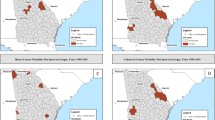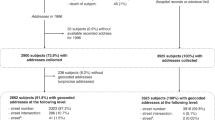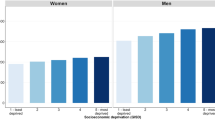Abstract
The interpretation of reports of clusters of childhood leukaemia is difficult, first because little is known about the causes of the disease, and second because there is insufficient information on whether cases show a generalized tendency to cluster geographically. The EUROCLUS project is a European collaborative study whose primary objective is to determine whether the residence locations of cases at diagnosis show a general tendency towards spatial clustering. The second objective is to interpret any patterns observed and, in particular, to see if clustering can be explained in terms of either infectious agents or environmental hazards as aetiological agents. The spatial distribution of 13351 cases of childhood leukaemia diagnosed in 17 countries between 1980 and 1989 has been analysed using the Potthoff-Whittinghill method. The overall results show statistically significant evidence of clustering of total childhood leukaemia within small census areas (P=0.03) but the magnitude of the clustering is small (extra-Poisson component of variance (%) = 1.7 with 90% confidence interval 0.2-3.1). The clustering is most marked in areas that have intermediate population density (150-499 persons km[-2]). It cannot be attributed to any specific age group at diagnosis or cell type and involves spatial aggregation of cases of different ages and cell types. The results indicate that intense clusters are a rare phenomenon that merit careful investigation, although aetiological insights are more likely to come from investigation of large numbers of cases. We present a method for detecting clustering that is simple and readily available to cancer registries and similar groups.
This is a preview of subscription content, access via your institution
Access options
Subscribe to this journal
Receive 24 print issues and online access
$259.00 per year
only $10.79 per issue
Buy this article
- Purchase on Springer Link
- Instant access to full article PDF
Prices may be subject to local taxes which are calculated during checkout
Similar content being viewed by others
Author information
Authors and Affiliations
Consortia
Rights and permissions
About this article
Cite this article
Alexander, F., Boyle, P., Carli, PM. et al. Spatial clustering of childhood leukaemia: summary results from the EUROCLUS project. Br J Cancer 77, 818–824 (1998). https://doi.org/10.1038/bjc.1998.133
Issue Date:
DOI: https://doi.org/10.1038/bjc.1998.133
This article is cited by
-
Childhood cancer research in Oxford II: The Childhood Cancer Research Group
British Journal of Cancer (2018)
-
A systematic review and meta-analysis of the association between childhood infections and the risk of childhood acute lymphoblastic leukaemia
British Journal of Cancer (2018)
-
Spatial Clustering of Childhood Acute Lymphoblastic Leukaemia in Hungary
Pathology & Oncology Research (2013)
-
Spatial clustering of leukemia and type 1 diabetes in children in Denmark
Cancer Causes & Control (2011)
-
Spatial clustering and space–time clusters of leukemia among children in Germany, 1987–2007
European Journal of Epidemiology (2010)



